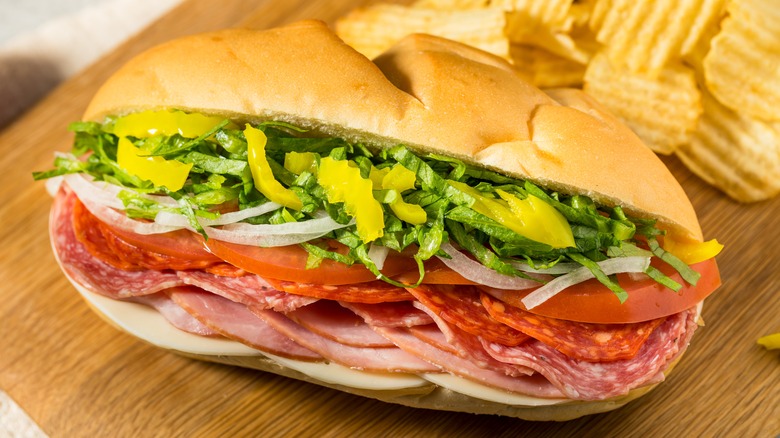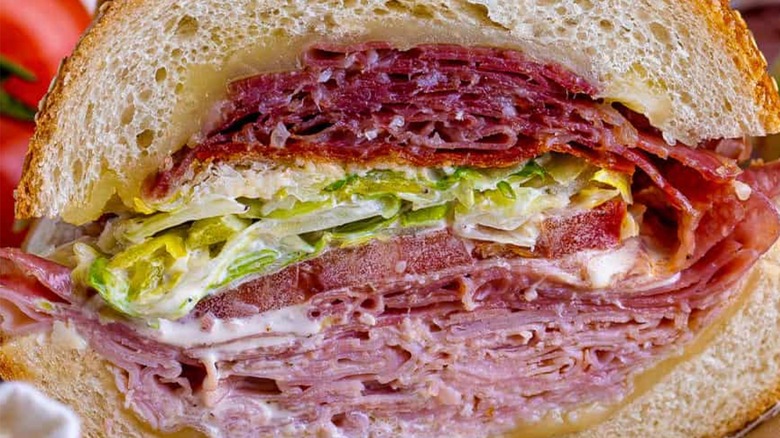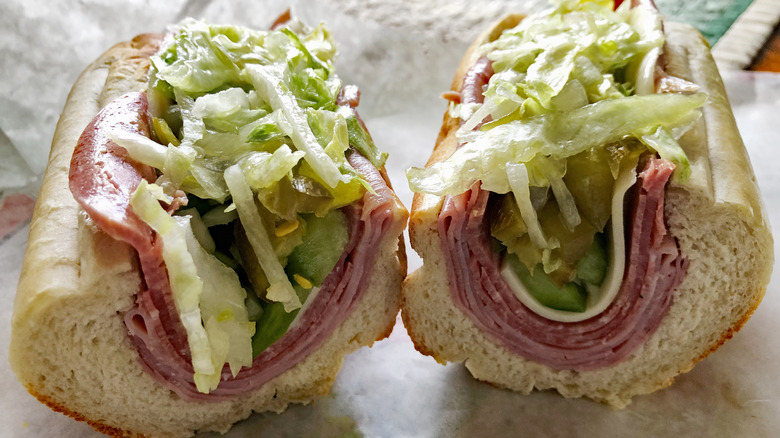Is There Really A Difference Between A Grinder Sandwich And A Sub?
If you've been on social media in the past few years, you've likely seen the resurgence of the grinder sandwich. Although this meal has been around since World War I, it gained popularity once again on TikTok in 2022, with videos circulating of meats, cheeses, and veggies piled high on big hoagie rolls. The trend was somewhat spurred by the deliciousness of the creamy, tangy dressing — but overall, these 'wiches are mouthwatering meals that would make any lunchtime scrollers hungry.
And yet, there are plenty of similar sandwiches that are tasty and just as hearty. Many grinder recipes bear an uncanny resemblance to regular Italian sub sandwiches, considering their bread and contents look almost exactly alike. So what is the difference between the two types? It's true that they are very close, and if you ask some people, the terms are interchangeable. But the main difference is that subs are generally served cold, while grinders are often hot. Plus, grinders have a separate origin story from subs. And while you can use a few different types of bread to make the latter, the classic version of the former boasts a specific Italian variety.
What is a grinder sandwich?
As we mentioned, grinder sandwiches first popped up during World War I. There are a few theories as to how they got their name, each of which originate in New England, which is primarily where you'll find sandwiches called by this name. At the time, Italian American dock workers were dubbed grinders because they would grind ships' exteriors so they could be repainted. Italian Americans also owned sandwich shops nearby, so the name carried over. However, it's possible that these sandwiches got their name from the crusty Italian bread they're made with — you know, the kind you grind your teeth on.
Either way, when people talk about grinder sandwiches today, they're referring to long rolls stuffed with various meats, cheeses, and veggies. Those crusty (but soft on the inside) Italian rolls are often used, and you'll also see other types of hoagie rolls in modern times. Grinders are typically warmed up after they're put together, and while straight mayo is a no-no, you may see the famous grinder dressing poured on instead. This typically includes mayo, olive oil, vinegar, Italian seasoning, salt, pepper, and minced pepperoncini or banana peppers, plus optional additions like garlic, minced red onion, and red pepper flakes.
What is a sub?
While grinder sandwiches are native to New England, we need to get more specific if we want to differentiate between the origins of grinders versus subs. Today, you'll see the term grinder primarily used in Connecticut and Rhode Island, while folks from Massachuetts (and a good portion of states outside of the East Coast) call these sandwiches subs. However, the sub may have actually been created in Connecticut. An Italian named Benedetto Capaldo, who owned a shop next to a World War II submarine base, may have helped popularize the name, as customers likened the shape of his sandwich to that of the naval vessels.
These long sandwiches are sometimes called hoagies (which also have wartime origins) or hero sandwiches, but sub is the most all-encompassing term for them. For the most part, you'll see them served cold — but of course, there are exceptions and variations, like the classic meatball sub. Unlike other types of sandwiches, they're stuffed horizontally, with connecting top and bottom portions of bread. They have to be at least six inches long, and you'll often see foot-long versions. Subs can be filled with all kind of proteins — everything from pastrami to ham to roast beef — along with a variety of cheeses and veggies; shredded lettuce is a common option.


